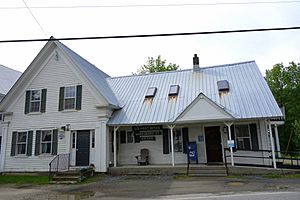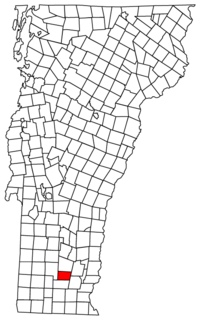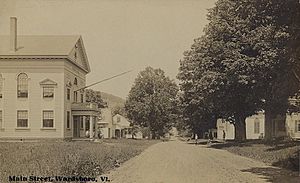Wardsboro, Vermont facts for kids
Quick facts for kids
Wardsboro, Vermont
|
|
|---|---|

US Post Office Wardsboro
|
|

Wardsboro, Vermont
|
|
| Country | United States |
| State | Vermont |
| County | Windham |
| Chartered | 1780 |
| Communities |
|
| Area | |
| • Total | 29.3 sq mi (75.8 km2) |
| • Land | 29.3 sq mi (75.8 km2) |
| • Water | 0.0 sq mi (0.0 km2) |
| Elevation | 1,391 ft (424 m) |
| Population
(2020)
|
|
| • Total | 869 |
| • Density | 30/sq mi (11.5/km2) |
| Time zone | UTC-5 (Eastern (EST)) |
| • Summer (DST) | UTC-4 (EDT) |
| ZIP Codes |
05355 (Wardsboro)
05360 (West Wardsboro) |
| Area code(s) | 802 |
| FIPS code | 50-76225 |
| GNIS feature ID | 1462241 |
Wardsboro is a town in Windham County, Vermont, in the United States. In 2020, about 869 people lived there. The town includes several small communities. These are Wardsboro, Wardsboro Center, West Wardsboro, and South Wardsboro.
Contents
History of Wardsboro
Early Settlement and Naming
Wardsboro was first settled around 1779. Samuel Davis and his wife, who came from Milford, Massachusetts, were among the first to arrive. The town was officially given its charter on November 7, 1780. It was named after William Ward of Newfane, who received the land grant along with 62 other people.
Town Division and Growth
In 1788, the town was split into two parts: a north district and a south district. The southern part later became its own town called Dover in 1810. Even though the land in Wardsboro was hilly and rocky, farmers worked hard to make it productive.
Industries and Changes
Many mills were built along the local brook, which flows into the West River. By 1859, Wardsboro had several important businesses. These included three gristmills (for grinding grain), six sawmills (for cutting wood), a tannery (for making leather), and a factory that made whips from rawhide.
During the Civil War, Wardsboro Center was known as Unionville. This name showed its strong support for the Union side. In the 1880s, a factory owned by Jebediah Estabrook was a major employer. It made tubs, buckets, and pails. In 1894, the U.S. Post Office changed the spelling of many town names. This is why "Wardsborough" became "Wardsboro."
Recent Events and the Gilfeather Turnip
In 2011, Hurricane Irene caused severe flooding in Vermont. Wardsboro was one of thirteen towns that became cut off from others. It was the last town to be reconnected.
In April 2016, the Vermont State Legislature chose the Gilfeather Turnip as the Official Vermont State Vegetable. This special type of turnip was first grown in the early 1900s by Farmer John Gilfeather at his farm in Wardsboro.
Community Events
Wardsboro hosts two main community events each year. The first is the 4th of July Street Fair and Parade. This event always takes place on July 4th, no matter what day of the week it is. The second big event is the Gilfeather Turnip Festival, which happens at the end of October.
Geography and Nature
Location and Landscape
Wardsboro covers about 29.3 square miles (75.8 km2) of land. There is no water area within the town limits. Wardsboro Brook flows through the town and is a tributary of the West River.
Outdoor Activities
The town is located in the Green Mountains. A large part of Wardsboro is inside the Green Mountain National Forest. This means there are many natural areas to explore. Wardsboro is also close to popular ski resorts. It is about six miles north of Mount Snow and less than 10 miles south of Stratton.
If you enjoy water activities, Somerset Reservoir and Grout Pond are just a few minutes away. For winter fun, Vermont Association of Snow Travelers Snowmobile trails run right through the town. Vermont Route 100 is a main road that crosses through Wardsboro.
Population Information
| Historical population | |||
|---|---|---|---|
| Census | Pop. | %± | |
| 1790 | 753 | — | |
| 1800 | 1,484 | 97.1% | |
| 1810 | 1,159 | −21.9% | |
| 1820 | 1,016 | −12.3% | |
| 1830 | 1,148 | 13.0% | |
| 1840 | 1,102 | −4.0% | |
| 1850 | 1,125 | 2.1% | |
| 1860 | 1,004 | −10.8% | |
| 1870 | 866 | −13.7% | |
| 1880 | 766 | −11.5% | |
| 1890 | 704 | −8.1% | |
| 1900 | 637 | −9.5% | |
| 1910 | 559 | −12.2% | |
| 1920 | 380 | −32.0% | |
| 1930 | 355 | −6.6% | |
| 1940 | 401 | 13.0% | |
| 1950 | 377 | −6.0% | |
| 1960 | 322 | −14.6% | |
| 1970 | 391 | 21.4% | |
| 1980 | 505 | 29.2% | |
| 1990 | 654 | 29.5% | |
| 2000 | 854 | 30.6% | |
| 2010 | 900 | 5.4% | |
| 2020 | 869 | −3.4% | |
| U.S. Decennial Census | |||
How Many People Live Here?
In 2010, there were 900 people living in Wardsboro. These people lived in 374 households, and 242 of these were families. The town had about 30.7 people per square mile. Most of the people living in Wardsboro (97.5%) were White. A small number were African American (1.2%) or from two or more races (1.1%). About 0.5% of the population was Hispanic or Latino.
In 2000, there were 854 people in Wardsboro. There were 358 households. About 28.8% of these households had children under 18 living there. Most households (54.5%) were married couples living together. The average household had 2.39 people.
Age Groups in Wardsboro
The population in Wardsboro is spread out across different age groups.
- About 23.7% of the people were under 18 years old.
- About 6.6% were between 18 and 24 years old.
- About 28.5% were between 25 and 44 years old.
- About 30.1% were between 45 and 64 years old.
- About 11.2% were 65 years old or older.
The average age in Wardsboro was 41 years old.
Notable People from Wardsboro
Many interesting people have connections to Wardsboro. Here are a few:
- Augustus F. Allen, a US congressman from New York
- Herbert G. Barber, a Vermont Attorney General
- Clarke C. Fitts, another Vermont Attorney General
- Abner Hazeltine, a US congressman
- Marshall Otis Howe, a Vermont state legislator
- Mary Eddy Kidder, a missionary and educator who worked in Japan
- Bill Jenkins, a former NASCAR team owner
- Miles Justice Knowlton, a clergyman and missionary
Climate in Wardsboro
Wardsboro has a type of climate known as a humid continental climate. This means the town experiences big changes in temperature throughout the year. Summers are usually warm to hot, and sometimes humid. Winters are cold, and can sometimes be very cold.
See also
 In Spanish: Wardsboro para niños
In Spanish: Wardsboro para niños



